ACC8000 - Compensation Strategies and Agency Theory Report
VerifiedAdded on 2023/06/11
|17
|4198
|102
Report
AI Summary
This report analyzes compensation packages within the framework of agency theory, particularly in the context of the Terrific Telephone Company. It addresses how fixed salaries may fail to motivate employees, explores various components of compensation packages like guaranteed pay, variable pay, benefits, and equity-based compensation, and discusses their impact on employee motivation in both the short and long term. The report further examines how an employee's risk attitude influences their desired compensation and identifies factors that limit the effectiveness of performance-based compensation. It also highlights the role of the executive compensation committee in reviewing executive compensation. Additionally, the report contrasts traditional and modern accounting approaches through the lens of agency theory and discusses the auditor's role as agents to shareholders, emphasizing the need for auditor independence and stricter controls. Finally, the report explores governance in non-profit organizations, critiquing the applicability of agency theory and suggesting stakeholder theory as an alternative.
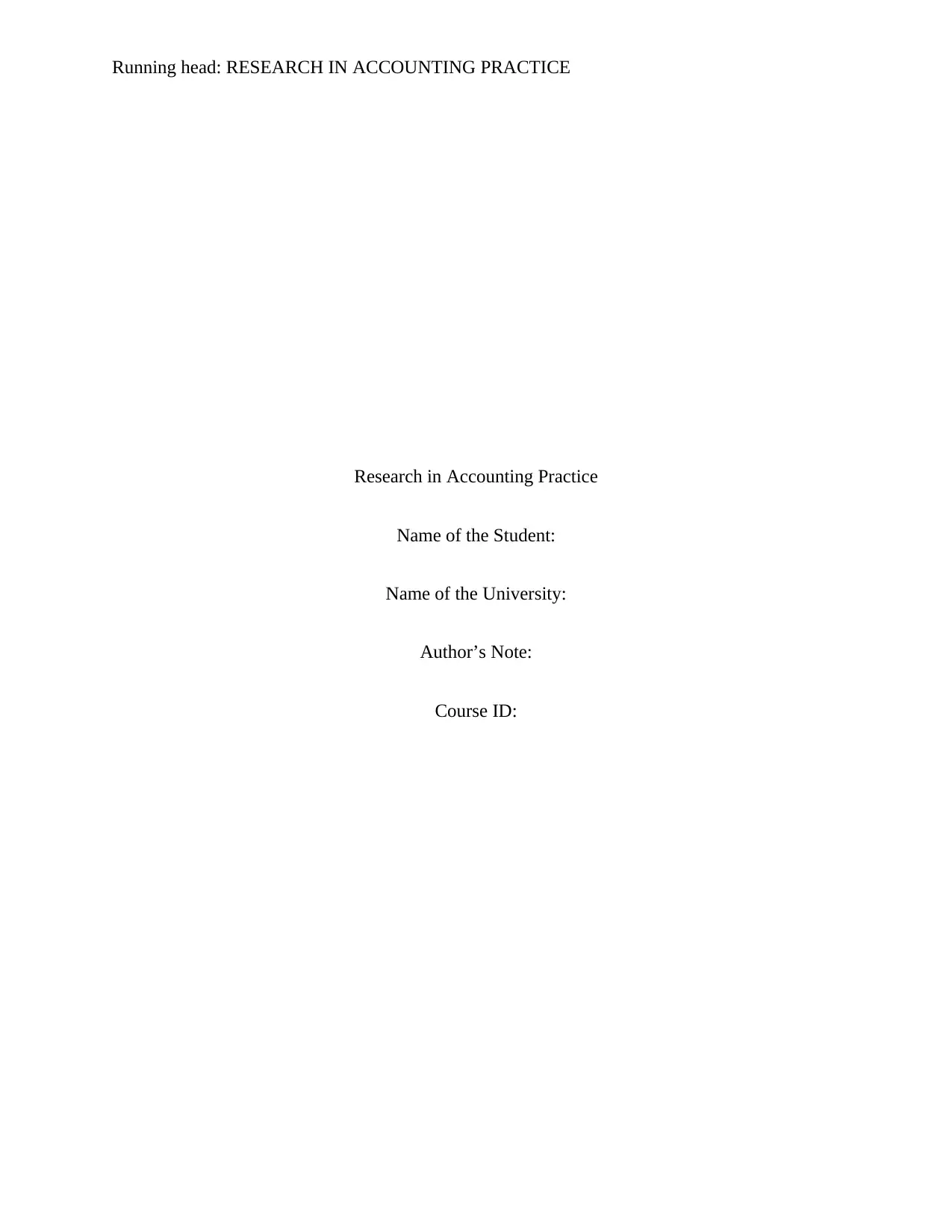
Running head: RESEARCH IN ACCOUNTING PRACTICE
Research in Accounting Practice
Name of the Student:
Name of the University:
Author’s Note:
Course ID:
Research in Accounting Practice
Name of the Student:
Name of the University:
Author’s Note:
Course ID:
Paraphrase This Document
Need a fresh take? Get an instant paraphrase of this document with our AI Paraphraser

1RESEARCH IN ACCOUNTING PRACTICE
Table of Contents
Question 1:.......................................................................................................................................3
Answer to Part a:.........................................................................................................................3
Answer to Part b:.........................................................................................................................4
Answer to Part c:.........................................................................................................................5
Answer to Part d:.........................................................................................................................6
Answer to Part e:.........................................................................................................................6
Question 2:.......................................................................................................................................7
Answer to Part a:.........................................................................................................................7
Answer to Part b:.........................................................................................................................7
Question 3:.......................................................................................................................................8
Answer to Part a:.........................................................................................................................8
Answer to Part b:.........................................................................................................................8
Answer to Part c:.........................................................................................................................9
Question 4:.......................................................................................................................................9
Answer to Part a:.........................................................................................................................9
Answer to Part b:.......................................................................................................................10
Part i:......................................................................................................................................10
Part ii:.....................................................................................................................................10
Table of Contents
Question 1:.......................................................................................................................................3
Answer to Part a:.........................................................................................................................3
Answer to Part b:.........................................................................................................................4
Answer to Part c:.........................................................................................................................5
Answer to Part d:.........................................................................................................................6
Answer to Part e:.........................................................................................................................6
Question 2:.......................................................................................................................................7
Answer to Part a:.........................................................................................................................7
Answer to Part b:.........................................................................................................................7
Question 3:.......................................................................................................................................8
Answer to Part a:.........................................................................................................................8
Answer to Part b:.........................................................................................................................8
Answer to Part c:.........................................................................................................................9
Question 4:.......................................................................................................................................9
Answer to Part a:.........................................................................................................................9
Answer to Part b:.......................................................................................................................10
Part i:......................................................................................................................................10
Part ii:.....................................................................................................................................10
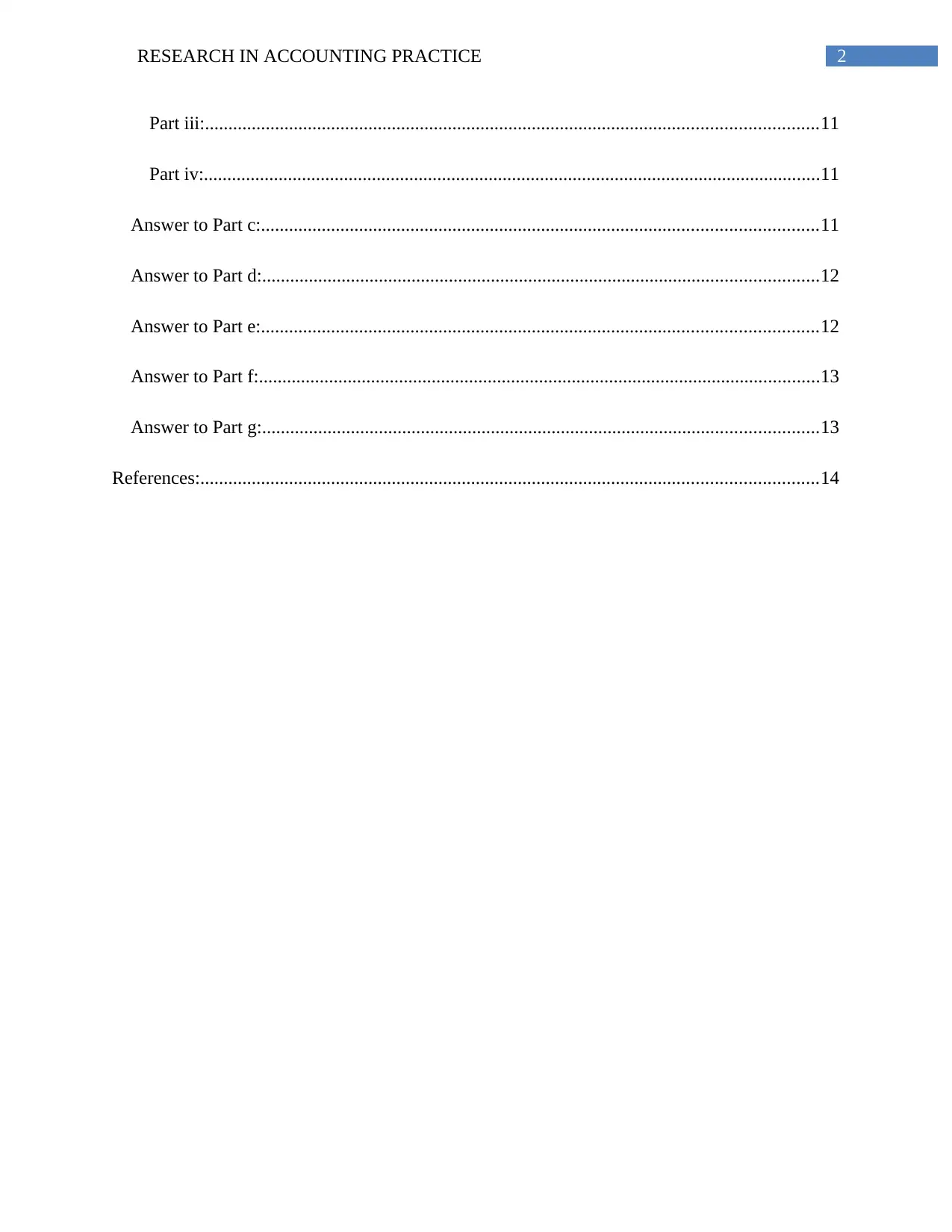
2RESEARCH IN ACCOUNTING PRACTICE
Part iii:...................................................................................................................................11
Part iv:....................................................................................................................................11
Answer to Part c:.......................................................................................................................11
Answer to Part d:.......................................................................................................................12
Answer to Part e:.......................................................................................................................12
Answer to Part f:........................................................................................................................13
Answer to Part g:.......................................................................................................................13
References:....................................................................................................................................14
Part iii:...................................................................................................................................11
Part iv:....................................................................................................................................11
Answer to Part c:.......................................................................................................................11
Answer to Part d:.......................................................................................................................12
Answer to Part e:.......................................................................................................................12
Answer to Part f:........................................................................................................................13
Answer to Part g:.......................................................................................................................13
References:....................................................................................................................................14
⊘ This is a preview!⊘
Do you want full access?
Subscribe today to unlock all pages.

Trusted by 1+ million students worldwide

3RESEARCH IN ACCOUNTING PRACTICE
Question 1:
Answer to Part a:
According to the agency theory, there is a popular view associated with employment
contracts. This is to link compensation as much as possible with the performance measurements.
Moreover, this varies from business to business, industry to industry and individuals to
individuals (Rebele & Pierre 2015). The labour market could be segregated into primary market
and secondary market depending on the ways the different workers would be compensated. The
workers in the primary market would be compensated based on their skills, while the market
forces determine the wages for the workers in the secondary market. This is identified as a
principal-agent problem in agency theory.
In order to deal with this issue, tipping could be viewed as a form of payment. From the
theoretical perspective, the interest of the principal is aligned with the agent, which is service
quality, with the help of tipping (Dai, Free & Gendron 2016). The reason is that it is the metric,
which the customers use for ascertaining the tip. However, this method is inappropriate for the
restaurants. The tip amount could not be associated with the service quality and thus, it could be
discriminatory. The other compensation forms could enable in aligning the interests of the staffs
with those of the employers. For instance, the performance pay schedules might result in fall in
the quality of work rendered by the employees, if they feel that effective recognition of their
efforts is not made accordingly. By combining all these factors, it could be stated that salaries
alone might not be able to motivate the employees in accordance with the agency theory.
Question 1:
Answer to Part a:
According to the agency theory, there is a popular view associated with employment
contracts. This is to link compensation as much as possible with the performance measurements.
Moreover, this varies from business to business, industry to industry and individuals to
individuals (Rebele & Pierre 2015). The labour market could be segregated into primary market
and secondary market depending on the ways the different workers would be compensated. The
workers in the primary market would be compensated based on their skills, while the market
forces determine the wages for the workers in the secondary market. This is identified as a
principal-agent problem in agency theory.
In order to deal with this issue, tipping could be viewed as a form of payment. From the
theoretical perspective, the interest of the principal is aligned with the agent, which is service
quality, with the help of tipping (Dai, Free & Gendron 2016). The reason is that it is the metric,
which the customers use for ascertaining the tip. However, this method is inappropriate for the
restaurants. The tip amount could not be associated with the service quality and thus, it could be
discriminatory. The other compensation forms could enable in aligning the interests of the staffs
with those of the employers. For instance, the performance pay schedules might result in fall in
the quality of work rendered by the employees, if they feel that effective recognition of their
efforts is not made accordingly. By combining all these factors, it could be stated that salaries
alone might not be able to motivate the employees in accordance with the agency theory.
Paraphrase This Document
Need a fresh take? Get an instant paraphrase of this document with our AI Paraphraser
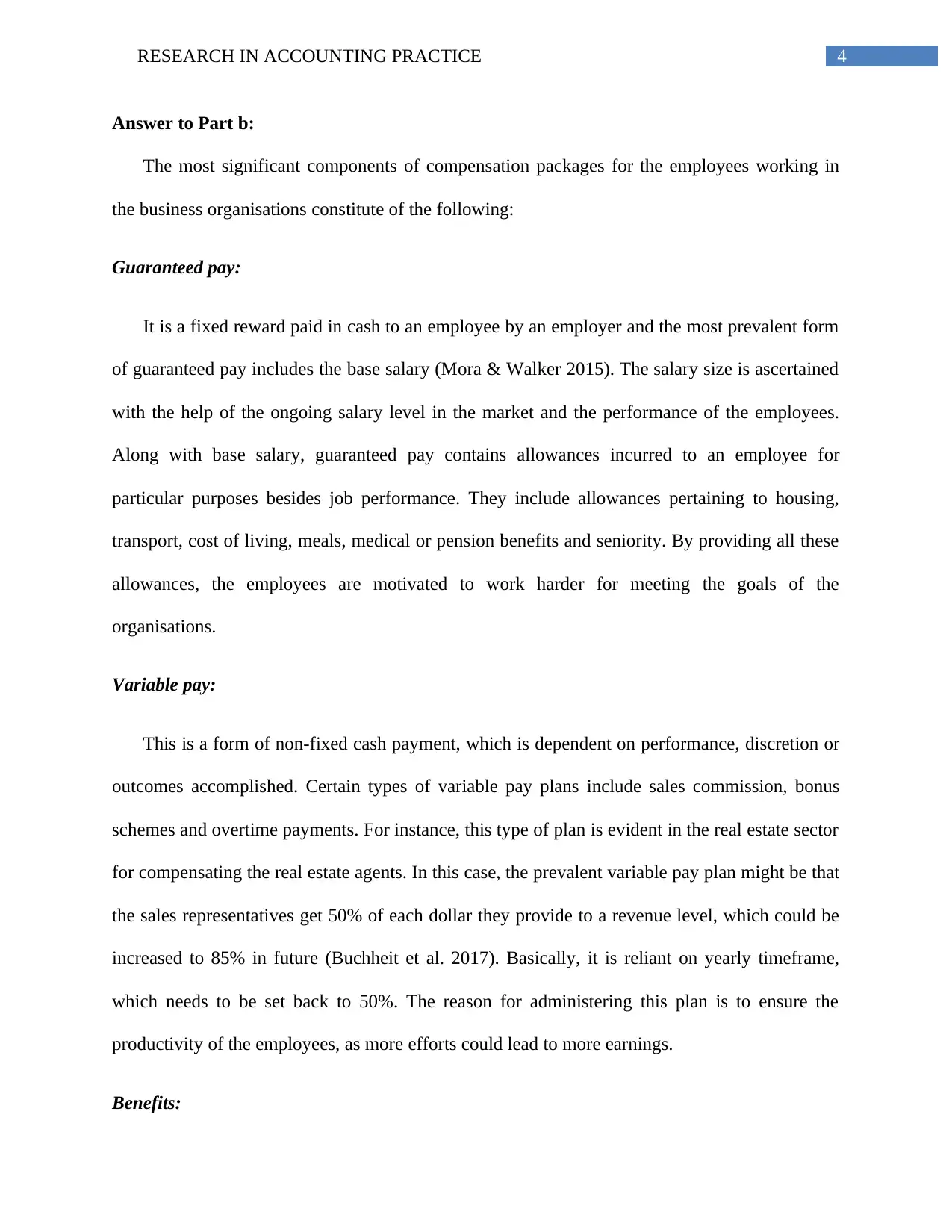
4RESEARCH IN ACCOUNTING PRACTICE
Answer to Part b:
The most significant components of compensation packages for the employees working in
the business organisations constitute of the following:
Guaranteed pay:
It is a fixed reward paid in cash to an employee by an employer and the most prevalent form
of guaranteed pay includes the base salary (Mora & Walker 2015). The salary size is ascertained
with the help of the ongoing salary level in the market and the performance of the employees.
Along with base salary, guaranteed pay contains allowances incurred to an employee for
particular purposes besides job performance. They include allowances pertaining to housing,
transport, cost of living, meals, medical or pension benefits and seniority. By providing all these
allowances, the employees are motivated to work harder for meeting the goals of the
organisations.
Variable pay:
This is a form of non-fixed cash payment, which is dependent on performance, discretion or
outcomes accomplished. Certain types of variable pay plans include sales commission, bonus
schemes and overtime payments. For instance, this type of plan is evident in the real estate sector
for compensating the real estate agents. In this case, the prevalent variable pay plan might be that
the sales representatives get 50% of each dollar they provide to a revenue level, which could be
increased to 85% in future (Buchheit et al. 2017). Basically, it is reliant on yearly timeframe,
which needs to be set back to 50%. The reason for administering this plan is to ensure the
productivity of the employees, as more efforts could lead to more earnings.
Benefits:
Answer to Part b:
The most significant components of compensation packages for the employees working in
the business organisations constitute of the following:
Guaranteed pay:
It is a fixed reward paid in cash to an employee by an employer and the most prevalent form
of guaranteed pay includes the base salary (Mora & Walker 2015). The salary size is ascertained
with the help of the ongoing salary level in the market and the performance of the employees.
Along with base salary, guaranteed pay contains allowances incurred to an employee for
particular purposes besides job performance. They include allowances pertaining to housing,
transport, cost of living, meals, medical or pension benefits and seniority. By providing all these
allowances, the employees are motivated to work harder for meeting the goals of the
organisations.
Variable pay:
This is a form of non-fixed cash payment, which is dependent on performance, discretion or
outcomes accomplished. Certain types of variable pay plans include sales commission, bonus
schemes and overtime payments. For instance, this type of plan is evident in the real estate sector
for compensating the real estate agents. In this case, the prevalent variable pay plan might be that
the sales representatives get 50% of each dollar they provide to a revenue level, which could be
increased to 85% in future (Buchheit et al. 2017). Basically, it is reliant on yearly timeframe,
which needs to be set back to 50%. The reason for administering this plan is to ensure the
productivity of the employees, as more efforts could lead to more earnings.
Benefits:
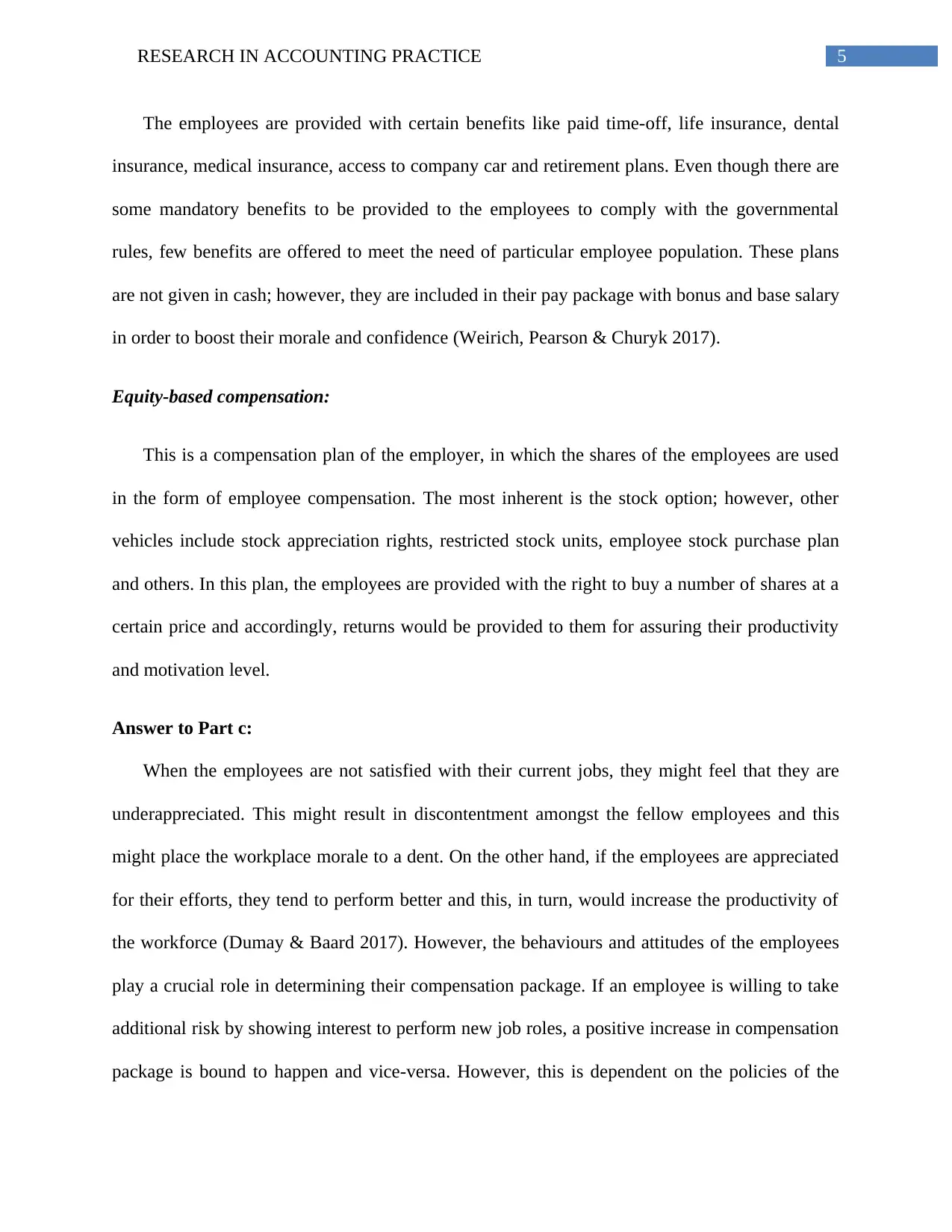
5RESEARCH IN ACCOUNTING PRACTICE
The employees are provided with certain benefits like paid time-off, life insurance, dental
insurance, medical insurance, access to company car and retirement plans. Even though there are
some mandatory benefits to be provided to the employees to comply with the governmental
rules, few benefits are offered to meet the need of particular employee population. These plans
are not given in cash; however, they are included in their pay package with bonus and base salary
in order to boost their morale and confidence (Weirich, Pearson & Churyk 2017).
Equity-based compensation:
This is a compensation plan of the employer, in which the shares of the employees are used
in the form of employee compensation. The most inherent is the stock option; however, other
vehicles include stock appreciation rights, restricted stock units, employee stock purchase plan
and others. In this plan, the employees are provided with the right to buy a number of shares at a
certain price and accordingly, returns would be provided to them for assuring their productivity
and motivation level.
Answer to Part c:
When the employees are not satisfied with their current jobs, they might feel that they are
underappreciated. This might result in discontentment amongst the fellow employees and this
might place the workplace morale to a dent. On the other hand, if the employees are appreciated
for their efforts, they tend to perform better and this, in turn, would increase the productivity of
the workforce (Dumay & Baard 2017). However, the behaviours and attitudes of the employees
play a crucial role in determining their compensation package. If an employee is willing to take
additional risk by showing interest to perform new job roles, a positive increase in compensation
package is bound to happen and vice-versa. However, this is dependent on the policies of the
The employees are provided with certain benefits like paid time-off, life insurance, dental
insurance, medical insurance, access to company car and retirement plans. Even though there are
some mandatory benefits to be provided to the employees to comply with the governmental
rules, few benefits are offered to meet the need of particular employee population. These plans
are not given in cash; however, they are included in their pay package with bonus and base salary
in order to boost their morale and confidence (Weirich, Pearson & Churyk 2017).
Equity-based compensation:
This is a compensation plan of the employer, in which the shares of the employees are used
in the form of employee compensation. The most inherent is the stock option; however, other
vehicles include stock appreciation rights, restricted stock units, employee stock purchase plan
and others. In this plan, the employees are provided with the right to buy a number of shares at a
certain price and accordingly, returns would be provided to them for assuring their productivity
and motivation level.
Answer to Part c:
When the employees are not satisfied with their current jobs, they might feel that they are
underappreciated. This might result in discontentment amongst the fellow employees and this
might place the workplace morale to a dent. On the other hand, if the employees are appreciated
for their efforts, they tend to perform better and this, in turn, would increase the productivity of
the workforce (Dumay & Baard 2017). However, the behaviours and attitudes of the employees
play a crucial role in determining their compensation package. If an employee is willing to take
additional risk by showing interest to perform new job roles, a positive increase in compensation
package is bound to happen and vice-versa. However, this is dependent on the policies of the
⊘ This is a preview!⊘
Do you want full access?
Subscribe today to unlock all pages.

Trusted by 1+ million students worldwide

6RESEARCH IN ACCOUNTING PRACTICE
organisations regarding whether they would provide rewards and benefits based on the work
performance of the employees and this, in turn, would influence the attitude to risk of the
employees.
Answer to Part d:
There are certain factors that might limit the efficiency of performance-based compensation
packages for the staffs to work productively, out of which the four most significant factors are
demonstrated as follows:
One of the primary failures of performance-based compensation package is that the
strategy for the organisation is not developed (D. Parker & Guthrie 2014). If the strategic
goal of the organisation is to be engaged in local community, a part of the bonus needs to
be tied to the individual engagement of the employee in associations, boards along with
other community events. Thus, in the absence of link to the business strategy, there is risk
in promoting behaviours contradictory to the depicted strategy.
Another factor is the absence of best practices like zero-injury workplace, process of bid
selection, individual development, pre-job planning, negotiated work and others.
Most business organisations measure employee performance in terms of profitability
alone. However, profits are of no importance, if they run out of cash and receivables
could not be accumulated.
Answer to Part e:
With the help of executive compensation committee, it is possible to review the
compensation of the Chief Executive Officer (CEO) and the other executive officers of the
organisation. Moreover, this committee helps in demonstrating the procedure taking into
organisations regarding whether they would provide rewards and benefits based on the work
performance of the employees and this, in turn, would influence the attitude to risk of the
employees.
Answer to Part d:
There are certain factors that might limit the efficiency of performance-based compensation
packages for the staffs to work productively, out of which the four most significant factors are
demonstrated as follows:
One of the primary failures of performance-based compensation package is that the
strategy for the organisation is not developed (D. Parker & Guthrie 2014). If the strategic
goal of the organisation is to be engaged in local community, a part of the bonus needs to
be tied to the individual engagement of the employee in associations, boards along with
other community events. Thus, in the absence of link to the business strategy, there is risk
in promoting behaviours contradictory to the depicted strategy.
Another factor is the absence of best practices like zero-injury workplace, process of bid
selection, individual development, pre-job planning, negotiated work and others.
Most business organisations measure employee performance in terms of profitability
alone. However, profits are of no importance, if they run out of cash and receivables
could not be accumulated.
Answer to Part e:
With the help of executive compensation committee, it is possible to review the
compensation of the Chief Executive Officer (CEO) and the other executive officers of the
organisation. Moreover, this committee helps in demonstrating the procedure taking into
Paraphrase This Document
Need a fresh take? Get an instant paraphrase of this document with our AI Paraphraser
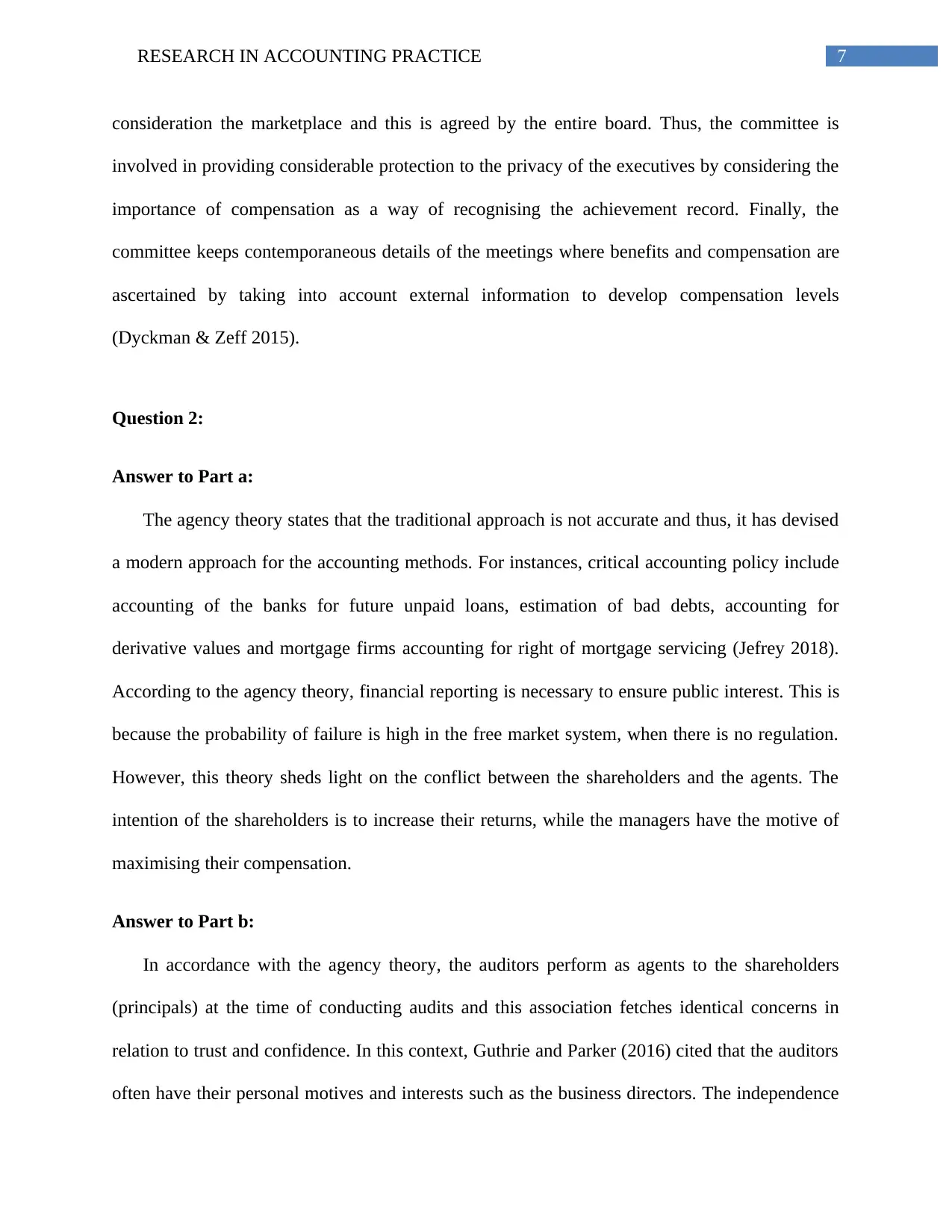
7RESEARCH IN ACCOUNTING PRACTICE
consideration the marketplace and this is agreed by the entire board. Thus, the committee is
involved in providing considerable protection to the privacy of the executives by considering the
importance of compensation as a way of recognising the achievement record. Finally, the
committee keeps contemporaneous details of the meetings where benefits and compensation are
ascertained by taking into account external information to develop compensation levels
(Dyckman & Zeff 2015).
Question 2:
Answer to Part a:
The agency theory states that the traditional approach is not accurate and thus, it has devised
a modern approach for the accounting methods. For instances, critical accounting policy include
accounting of the banks for future unpaid loans, estimation of bad debts, accounting for
derivative values and mortgage firms accounting for right of mortgage servicing (Jefrey 2018).
According to the agency theory, financial reporting is necessary to ensure public interest. This is
because the probability of failure is high in the free market system, when there is no regulation.
However, this theory sheds light on the conflict between the shareholders and the agents. The
intention of the shareholders is to increase their returns, while the managers have the motive of
maximising their compensation.
Answer to Part b:
In accordance with the agency theory, the auditors perform as agents to the shareholders
(principals) at the time of conducting audits and this association fetches identical concerns in
relation to trust and confidence. In this context, Guthrie and Parker (2016) cited that the auditors
often have their personal motives and interests such as the business directors. The independence
consideration the marketplace and this is agreed by the entire board. Thus, the committee is
involved in providing considerable protection to the privacy of the executives by considering the
importance of compensation as a way of recognising the achievement record. Finally, the
committee keeps contemporaneous details of the meetings where benefits and compensation are
ascertained by taking into account external information to develop compensation levels
(Dyckman & Zeff 2015).
Question 2:
Answer to Part a:
The agency theory states that the traditional approach is not accurate and thus, it has devised
a modern approach for the accounting methods. For instances, critical accounting policy include
accounting of the banks for future unpaid loans, estimation of bad debts, accounting for
derivative values and mortgage firms accounting for right of mortgage servicing (Jefrey 2018).
According to the agency theory, financial reporting is necessary to ensure public interest. This is
because the probability of failure is high in the free market system, when there is no regulation.
However, this theory sheds light on the conflict between the shareholders and the agents. The
intention of the shareholders is to increase their returns, while the managers have the motive of
maximising their compensation.
Answer to Part b:
In accordance with the agency theory, the auditors perform as agents to the shareholders
(principals) at the time of conducting audits and this association fetches identical concerns in
relation to trust and confidence. In this context, Guthrie and Parker (2016) cited that the auditors
often have their personal motives and interests such as the business directors. The independence
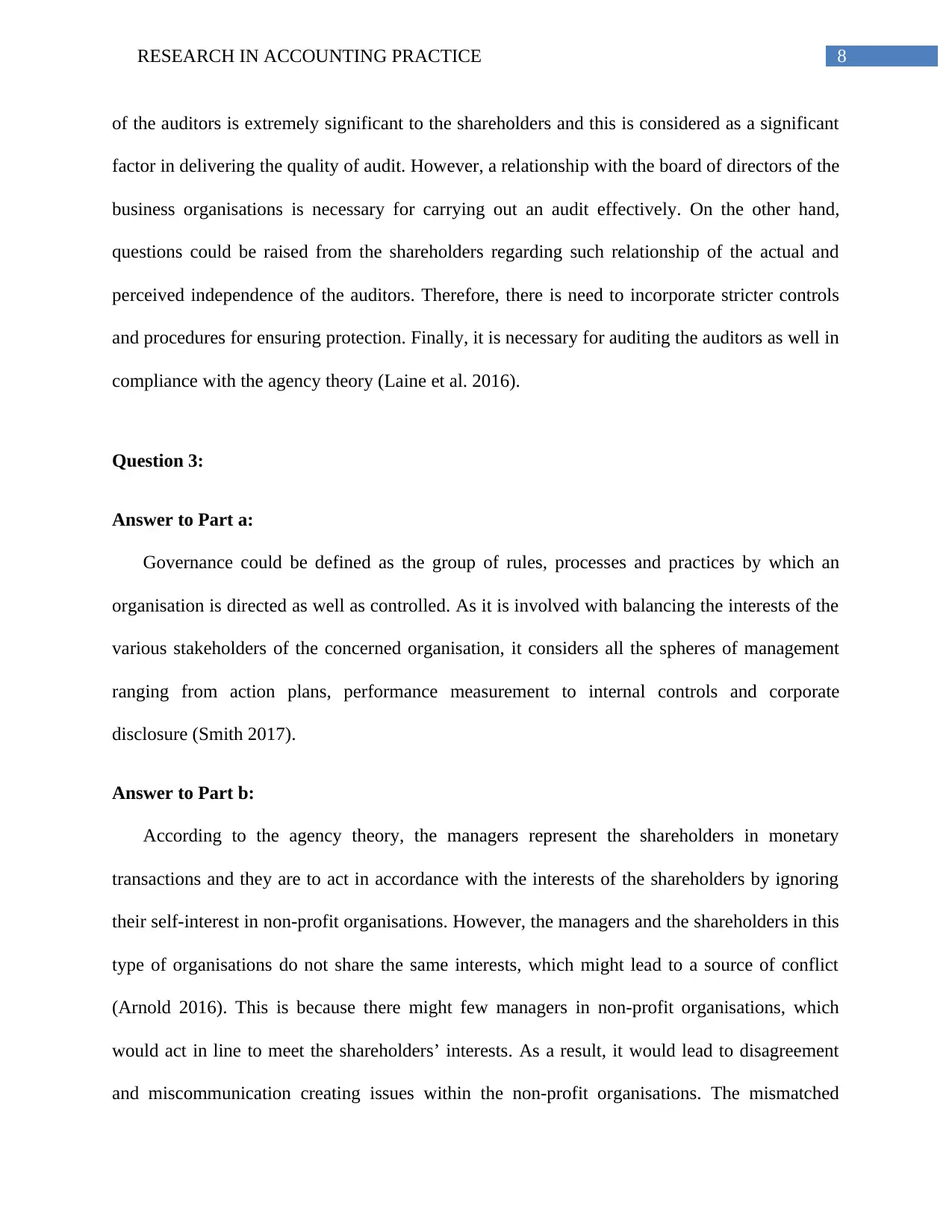
8RESEARCH IN ACCOUNTING PRACTICE
of the auditors is extremely significant to the shareholders and this is considered as a significant
factor in delivering the quality of audit. However, a relationship with the board of directors of the
business organisations is necessary for carrying out an audit effectively. On the other hand,
questions could be raised from the shareholders regarding such relationship of the actual and
perceived independence of the auditors. Therefore, there is need to incorporate stricter controls
and procedures for ensuring protection. Finally, it is necessary for auditing the auditors as well in
compliance with the agency theory (Laine et al. 2016).
Question 3:
Answer to Part a:
Governance could be defined as the group of rules, processes and practices by which an
organisation is directed as well as controlled. As it is involved with balancing the interests of the
various stakeholders of the concerned organisation, it considers all the spheres of management
ranging from action plans, performance measurement to internal controls and corporate
disclosure (Smith 2017).
Answer to Part b:
According to the agency theory, the managers represent the shareholders in monetary
transactions and they are to act in accordance with the interests of the shareholders by ignoring
their self-interest in non-profit organisations. However, the managers and the shareholders in this
type of organisations do not share the same interests, which might lead to a source of conflict
(Arnold 2016). This is because there might few managers in non-profit organisations, which
would act in line to meet the shareholders’ interests. As a result, it would lead to disagreement
and miscommunication creating issues within the non-profit organisations. The mismatched
of the auditors is extremely significant to the shareholders and this is considered as a significant
factor in delivering the quality of audit. However, a relationship with the board of directors of the
business organisations is necessary for carrying out an audit effectively. On the other hand,
questions could be raised from the shareholders regarding such relationship of the actual and
perceived independence of the auditors. Therefore, there is need to incorporate stricter controls
and procedures for ensuring protection. Finally, it is necessary for auditing the auditors as well in
compliance with the agency theory (Laine et al. 2016).
Question 3:
Answer to Part a:
Governance could be defined as the group of rules, processes and practices by which an
organisation is directed as well as controlled. As it is involved with balancing the interests of the
various stakeholders of the concerned organisation, it considers all the spheres of management
ranging from action plans, performance measurement to internal controls and corporate
disclosure (Smith 2017).
Answer to Part b:
According to the agency theory, the managers represent the shareholders in monetary
transactions and they are to act in accordance with the interests of the shareholders by ignoring
their self-interest in non-profit organisations. However, the managers and the shareholders in this
type of organisations do not share the same interests, which might lead to a source of conflict
(Arnold 2016). This is because there might few managers in non-profit organisations, which
would act in line to meet the shareholders’ interests. As a result, it would lead to disagreement
and miscommunication creating issues within the non-profit organisations. The mismatched
⊘ This is a preview!⊘
Do you want full access?
Subscribe today to unlock all pages.

Trusted by 1+ million students worldwide
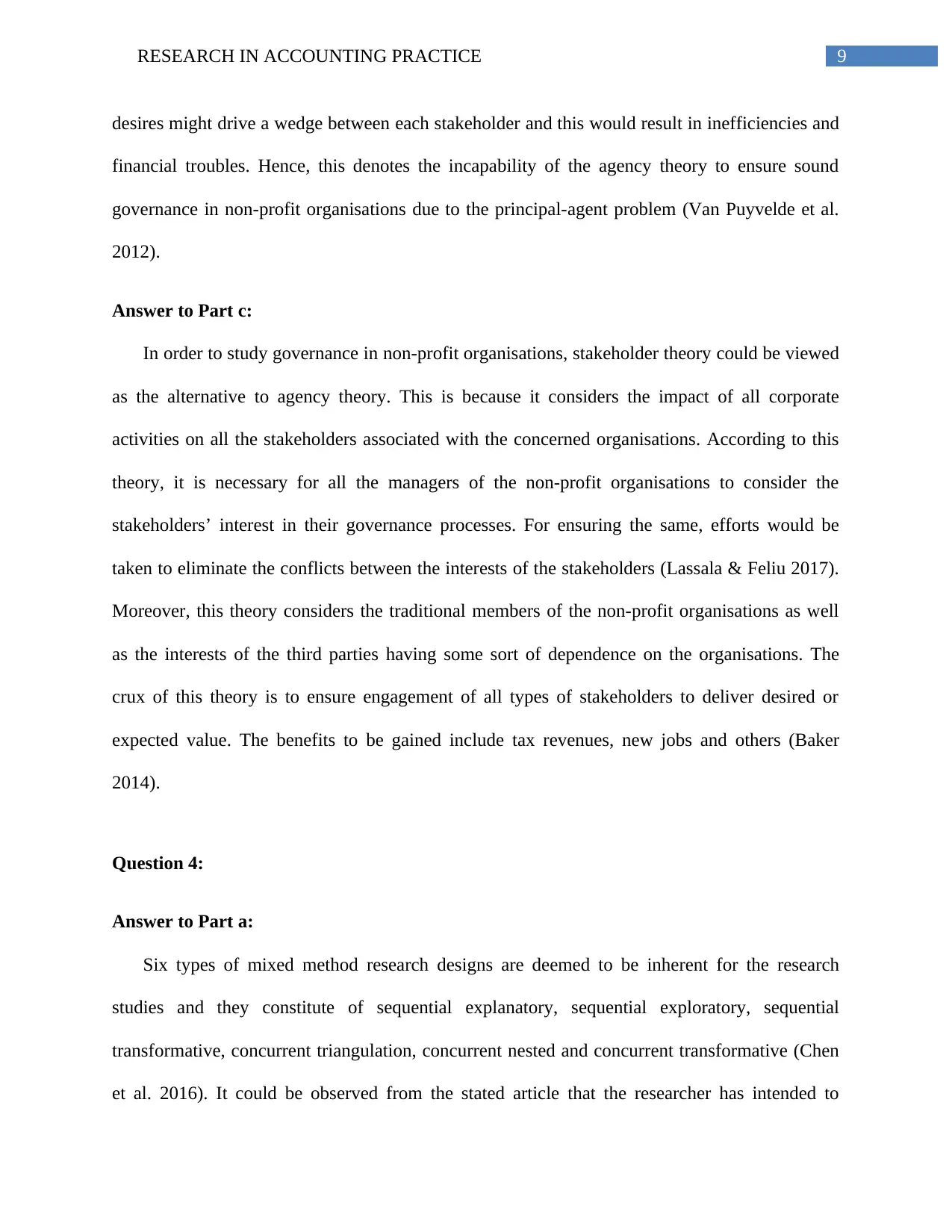
9RESEARCH IN ACCOUNTING PRACTICE
desires might drive a wedge between each stakeholder and this would result in inefficiencies and
financial troubles. Hence, this denotes the incapability of the agency theory to ensure sound
governance in non-profit organisations due to the principal-agent problem (Van Puyvelde et al.
2012).
Answer to Part c:
In order to study governance in non-profit organisations, stakeholder theory could be viewed
as the alternative to agency theory. This is because it considers the impact of all corporate
activities on all the stakeholders associated with the concerned organisations. According to this
theory, it is necessary for all the managers of the non-profit organisations to consider the
stakeholders’ interest in their governance processes. For ensuring the same, efforts would be
taken to eliminate the conflicts between the interests of the stakeholders (Lassala & Feliu 2017).
Moreover, this theory considers the traditional members of the non-profit organisations as well
as the interests of the third parties having some sort of dependence on the organisations. The
crux of this theory is to ensure engagement of all types of stakeholders to deliver desired or
expected value. The benefits to be gained include tax revenues, new jobs and others (Baker
2014).
Question 4:
Answer to Part a:
Six types of mixed method research designs are deemed to be inherent for the research
studies and they constitute of sequential explanatory, sequential exploratory, sequential
transformative, concurrent triangulation, concurrent nested and concurrent transformative (Chen
et al. 2016). It could be observed from the stated article that the researcher has intended to
desires might drive a wedge between each stakeholder and this would result in inefficiencies and
financial troubles. Hence, this denotes the incapability of the agency theory to ensure sound
governance in non-profit organisations due to the principal-agent problem (Van Puyvelde et al.
2012).
Answer to Part c:
In order to study governance in non-profit organisations, stakeholder theory could be viewed
as the alternative to agency theory. This is because it considers the impact of all corporate
activities on all the stakeholders associated with the concerned organisations. According to this
theory, it is necessary for all the managers of the non-profit organisations to consider the
stakeholders’ interest in their governance processes. For ensuring the same, efforts would be
taken to eliminate the conflicts between the interests of the stakeholders (Lassala & Feliu 2017).
Moreover, this theory considers the traditional members of the non-profit organisations as well
as the interests of the third parties having some sort of dependence on the organisations. The
crux of this theory is to ensure engagement of all types of stakeholders to deliver desired or
expected value. The benefits to be gained include tax revenues, new jobs and others (Baker
2014).
Question 4:
Answer to Part a:
Six types of mixed method research designs are deemed to be inherent for the research
studies and they constitute of sequential explanatory, sequential exploratory, sequential
transformative, concurrent triangulation, concurrent nested and concurrent transformative (Chen
et al. 2016). It could be observed from the stated article that the researcher has intended to
Paraphrase This Document
Need a fresh take? Get an instant paraphrase of this document with our AI Paraphraser
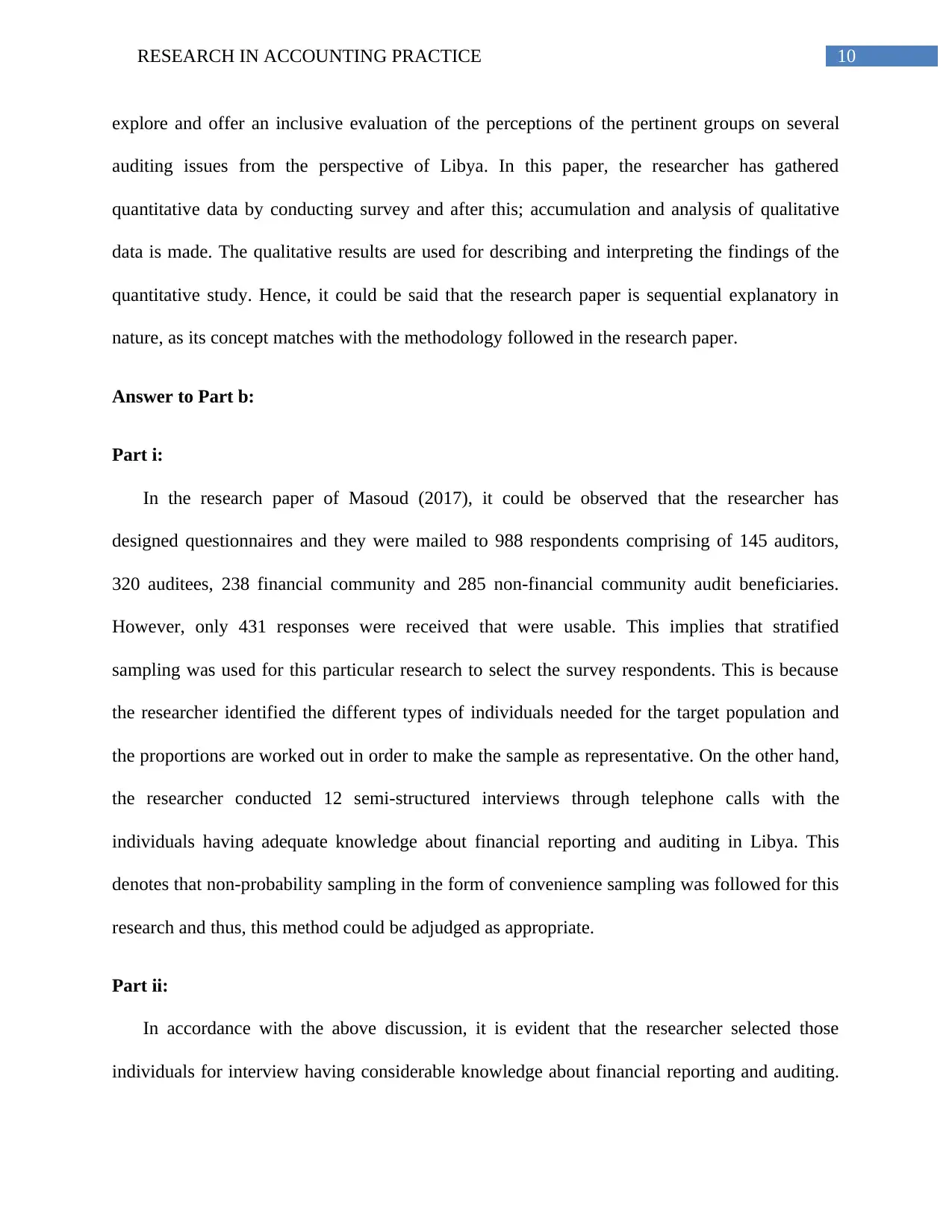
10RESEARCH IN ACCOUNTING PRACTICE
explore and offer an inclusive evaluation of the perceptions of the pertinent groups on several
auditing issues from the perspective of Libya. In this paper, the researcher has gathered
quantitative data by conducting survey and after this; accumulation and analysis of qualitative
data is made. The qualitative results are used for describing and interpreting the findings of the
quantitative study. Hence, it could be said that the research paper is sequential explanatory in
nature, as its concept matches with the methodology followed in the research paper.
Answer to Part b:
Part i:
In the research paper of Masoud (2017), it could be observed that the researcher has
designed questionnaires and they were mailed to 988 respondents comprising of 145 auditors,
320 auditees, 238 financial community and 285 non-financial community audit beneficiaries.
However, only 431 responses were received that were usable. This implies that stratified
sampling was used for this particular research to select the survey respondents. This is because
the researcher identified the different types of individuals needed for the target population and
the proportions are worked out in order to make the sample as representative. On the other hand,
the researcher conducted 12 semi-structured interviews through telephone calls with the
individuals having adequate knowledge about financial reporting and auditing in Libya. This
denotes that non-probability sampling in the form of convenience sampling was followed for this
research and thus, this method could be adjudged as appropriate.
Part ii:
In accordance with the above discussion, it is evident that the researcher selected those
individuals for interview having considerable knowledge about financial reporting and auditing.
explore and offer an inclusive evaluation of the perceptions of the pertinent groups on several
auditing issues from the perspective of Libya. In this paper, the researcher has gathered
quantitative data by conducting survey and after this; accumulation and analysis of qualitative
data is made. The qualitative results are used for describing and interpreting the findings of the
quantitative study. Hence, it could be said that the research paper is sequential explanatory in
nature, as its concept matches with the methodology followed in the research paper.
Answer to Part b:
Part i:
In the research paper of Masoud (2017), it could be observed that the researcher has
designed questionnaires and they were mailed to 988 respondents comprising of 145 auditors,
320 auditees, 238 financial community and 285 non-financial community audit beneficiaries.
However, only 431 responses were received that were usable. This implies that stratified
sampling was used for this particular research to select the survey respondents. This is because
the researcher identified the different types of individuals needed for the target population and
the proportions are worked out in order to make the sample as representative. On the other hand,
the researcher conducted 12 semi-structured interviews through telephone calls with the
individuals having adequate knowledge about financial reporting and auditing in Libya. This
denotes that non-probability sampling in the form of convenience sampling was followed for this
research and thus, this method could be adjudged as appropriate.
Part ii:
In accordance with the above discussion, it is evident that the researcher selected those
individuals for interview having considerable knowledge about financial reporting and auditing.
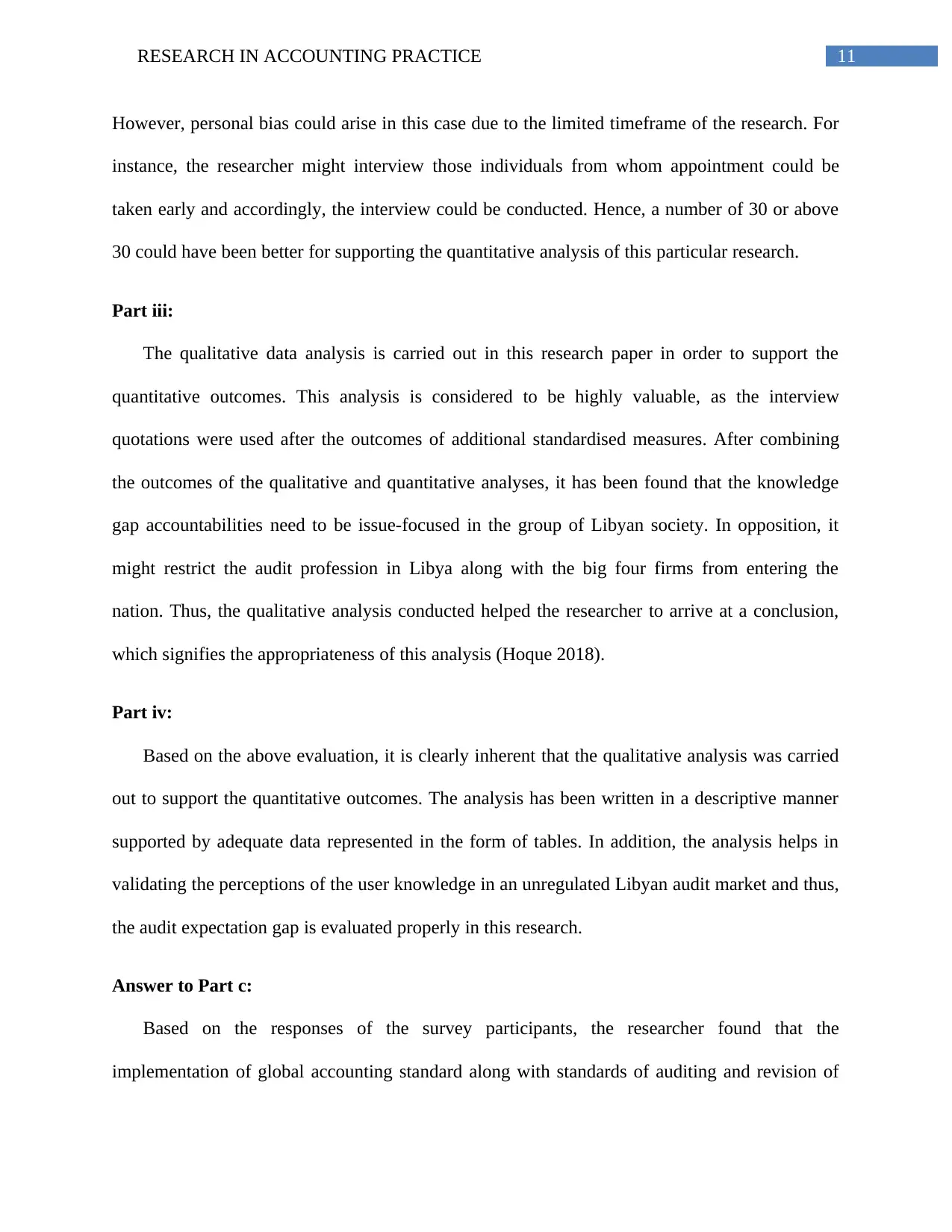
11RESEARCH IN ACCOUNTING PRACTICE
However, personal bias could arise in this case due to the limited timeframe of the research. For
instance, the researcher might interview those individuals from whom appointment could be
taken early and accordingly, the interview could be conducted. Hence, a number of 30 or above
30 could have been better for supporting the quantitative analysis of this particular research.
Part iii:
The qualitative data analysis is carried out in this research paper in order to support the
quantitative outcomes. This analysis is considered to be highly valuable, as the interview
quotations were used after the outcomes of additional standardised measures. After combining
the outcomes of the qualitative and quantitative analyses, it has been found that the knowledge
gap accountabilities need to be issue-focused in the group of Libyan society. In opposition, it
might restrict the audit profession in Libya along with the big four firms from entering the
nation. Thus, the qualitative analysis conducted helped the researcher to arrive at a conclusion,
which signifies the appropriateness of this analysis (Hoque 2018).
Part iv:
Based on the above evaluation, it is clearly inherent that the qualitative analysis was carried
out to support the quantitative outcomes. The analysis has been written in a descriptive manner
supported by adequate data represented in the form of tables. In addition, the analysis helps in
validating the perceptions of the user knowledge in an unregulated Libyan audit market and thus,
the audit expectation gap is evaluated properly in this research.
Answer to Part c:
Based on the responses of the survey participants, the researcher found that the
implementation of global accounting standard along with standards of auditing and revision of
However, personal bias could arise in this case due to the limited timeframe of the research. For
instance, the researcher might interview those individuals from whom appointment could be
taken early and accordingly, the interview could be conducted. Hence, a number of 30 or above
30 could have been better for supporting the quantitative analysis of this particular research.
Part iii:
The qualitative data analysis is carried out in this research paper in order to support the
quantitative outcomes. This analysis is considered to be highly valuable, as the interview
quotations were used after the outcomes of additional standardised measures. After combining
the outcomes of the qualitative and quantitative analyses, it has been found that the knowledge
gap accountabilities need to be issue-focused in the group of Libyan society. In opposition, it
might restrict the audit profession in Libya along with the big four firms from entering the
nation. Thus, the qualitative analysis conducted helped the researcher to arrive at a conclusion,
which signifies the appropriateness of this analysis (Hoque 2018).
Part iv:
Based on the above evaluation, it is clearly inherent that the qualitative analysis was carried
out to support the quantitative outcomes. The analysis has been written in a descriptive manner
supported by adequate data represented in the form of tables. In addition, the analysis helps in
validating the perceptions of the user knowledge in an unregulated Libyan audit market and thus,
the audit expectation gap is evaluated properly in this research.
Answer to Part c:
Based on the responses of the survey participants, the researcher found that the
implementation of global accounting standard along with standards of auditing and revision of
⊘ This is a preview!⊘
Do you want full access?
Subscribe today to unlock all pages.

Trusted by 1+ million students worldwide
1 out of 17
Related Documents
Your All-in-One AI-Powered Toolkit for Academic Success.
+13062052269
info@desklib.com
Available 24*7 on WhatsApp / Email
![[object Object]](/_next/static/media/star-bottom.7253800d.svg)
Unlock your academic potential
Copyright © 2020–2025 A2Z Services. All Rights Reserved. Developed and managed by ZUCOL.





